Grab some popcorn and don your finest togas, as we’re about to embark on a journey back in time to the glorious days of Ancient Rome!
Just like the colosseum’s grand spectacle, the world of cinema has offered us a plethora of epic tales set against the backdrop of this awe-inspiring civilization. From the thunderous roar of chariots to the whispers of political intrigue, these films transport us to a realm where emperors ruled with iron fists, gladiators battled for their freedom, and love stories unfolded amidst crumbling marble statues.
So, pull out your laurel wreaths and prepare to be transported to a time when togas and tunics were the epitome of fashion, marble statues came to life, and the allure of Ancient Rome beckoned from the silver screen. Join us as we unravel the epic tales and iconic characters that have forever etched Ancient Rome into the pantheon of cinematic greatness! Here are our top 10 best movies set in Ancient Rome!
10. The Last Days of Pompeii (1935)

What’s it about? Marcus, a young Roman blacksmith, falls in love with a noblewoman named Ione. As the volcanic fury of Mount Vesuvius looms, their lives become entangled with treachery, rivalry, and the pursuit of hidden treasure. Amidst the chaos and impending destruction, Marcus must navigate the perils of a city on the brink of obliteration while trying to save his love and survive the cataclysmic eruption that will forever change the fate of Pompeii.
Why is it great? Firstly, it captures the grandeur and scale of Ancient Rome, showcasing impressive sets and costumes that transport viewers back in time. The film also effectively builds tension as the eruption of Mount Vesuvius draws near, creating a sense of impending doom and a thrilling atmosphere. Additionally, the movie explores themes of love, loyalty, and sacrifice, adding depth to the characters and their motivations. Lastly, the spectacular special effects for its time, particularly the portrayal of the volcano’s eruption, were groundbreaking and still hold up today, adding to its overall appeal and cinematic value.
Fun fact: The film was directed by Ernest B. Schoedsack, who was also known for co-directing the original “King Kong” (1933) film.
9. Agora (2009)

What’s it about? The movie is set in 4th-century Alexandria and follows the life of Hypatia, a renowned philosopher and mathematician. As religious tensions rise between Christians and pagans, Hypatia finds herself caught in the middle. The film explores her quest for knowledge, her struggle to preserve intellectual freedom, and the conflicts that arise during the decline of the Roman Empire. Amidst the backdrop of political and religious upheaval, Hypatia’s ideals and teachings are challenged, making her a symbol of resistance against the growing fanaticism and the fight for intellectual enlightenment in a changing world.
Why is it great? Firstly, it offers a thought-provoking exploration of historical events, shedding light on a lesser-known period of ancient history—the religious and political tensions in 4th-century Alexandria. The film’s engaging storytelling and well-developed characters, particularly the portrayal of Hypatia by Rachel Weisz, captivate viewers and draw them into the narrative. Additionally, “Agora” tackles significant themes such as intellectual freedom, religious intolerance, and the clash between science and faith, sparking meaningful discussions and reflection. The film’s visual and production design, including its impressive recreations of ancient Alexandria, add to its appeal.
Fun fact: Rachel Weisz, who portrayed Hypatia in the film, studied philosophy in college, which helped her connect with the character on a deeper level.
8. The Robe (1953)
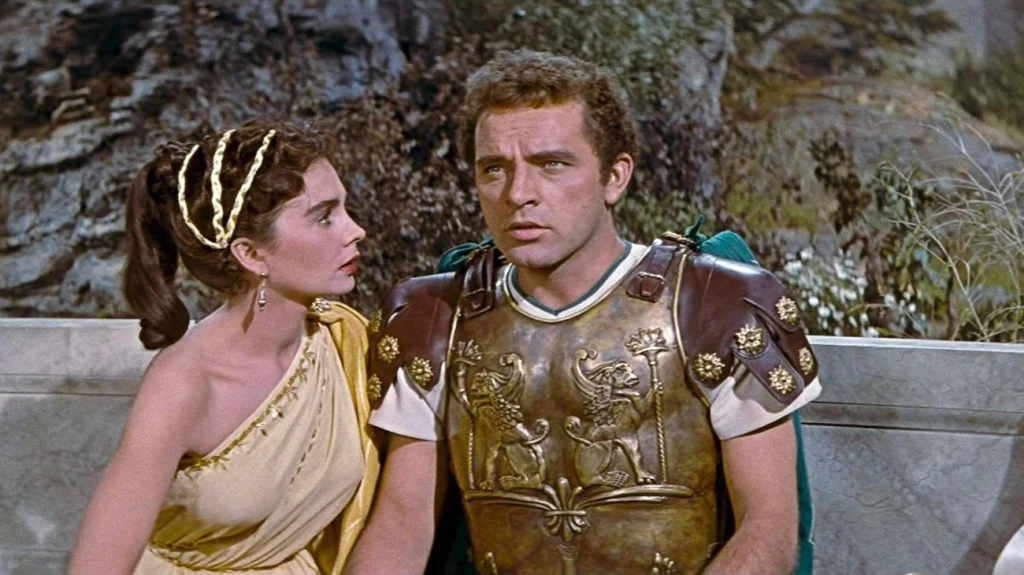
What’s it about? It follows Marcellus Gallio, a Roman tribune who wins Jesus’ robe in a gambling game at the crucifixion. Plagued by guilt and plagued by nightmares, Marcellus seeks to uncover the truth behind Jesus’ teachings. His journey leads him to encounter Christianity, face internal conflicts, and confront the powerful Roman Empire. Through spiritual transformation and personal sacrifice, Marcellus finds redemption and a renewed sense of purpose, ultimately embracing his faith and the robe as symbols of divine grace and forgiveness.
Why is it great? Firstly, it was one of the first major motion pictures to explore the themes of Christianity and the crucifixion of Jesus Christ, marking a significant moment in cinematic history. Moreover, the powerful performances, particularly by Richard Burton as Marcellus Gallio, bring depth and emotional resonance to the story. “The Robe” delves into themes of guilt, redemption, and spiritual transformation, offering a thoughtful exploration of faith and the impact it can have on an individual’s life. Its compelling narrative and timeless messages continue to resonate with audiences, making it a memorable and influential film in the realm of religious cinema.
Fun fact: It was the first film to be released in the widescreen format known as CinemaScope, which revolutionized the movie industry by offering a larger aspect ratio and a more immersive cinematic experience.
7. The Fall of the Roman Empire (1964)
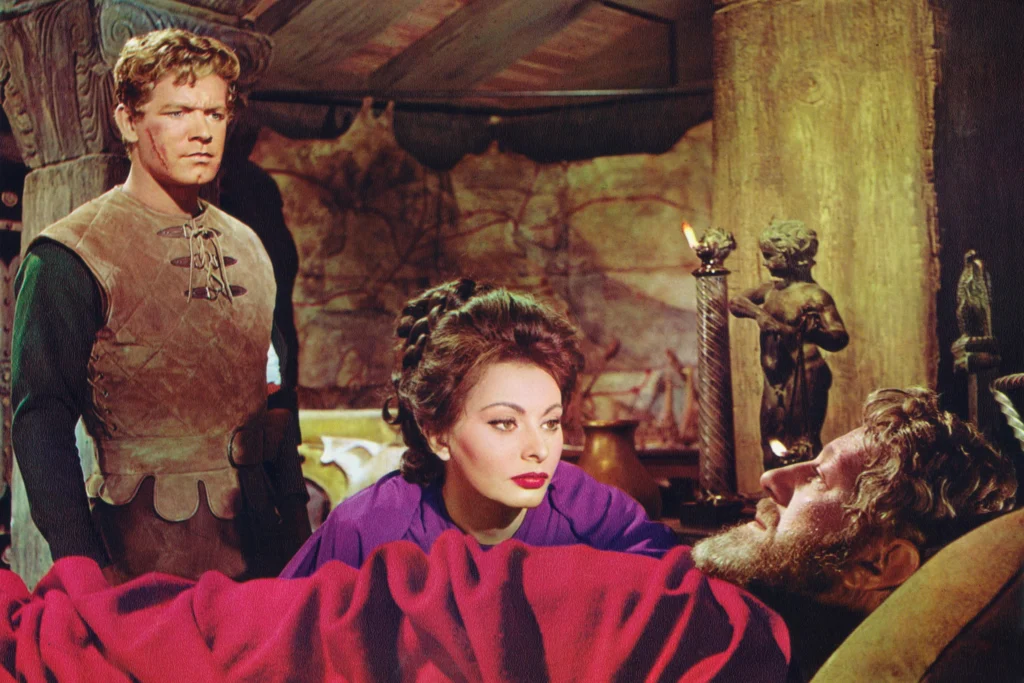
What’s it about? The film follows the political and military conflicts surrounding Emperor Aurelius and his successor, Commodus, as well as the love triangle involving Aurelius’ daughter, Lucilla, and two military commanders, Livius and Timonides. As the empire faces internal strife, corruption, and external threats, the film explores themes of power, loyalty, and the consequences of hubris, culminating in the eventual downfall of one of history’s greatest empires.
Why is it great? Firstly, it boasts an impressive ensemble cast, including renowned actors such as Sophia Loren, Alec Guinness, and Christopher Plummer, who deliver compelling performances that breathe life into their characters. Additionally, the film tackles complex themes of political intrigue, moral decay, and the consequences of unchecked power, offering thought-provoking reflections on the rise and fall of civilizations.
Fun fact: The film was directed by Anthony Mann, known for his work in the Western genre, and marked his first and only attempt at an epic historical drama. By the way, we have a separate top 10 list for Western movies as well!
6. Quo Vadis (1951)
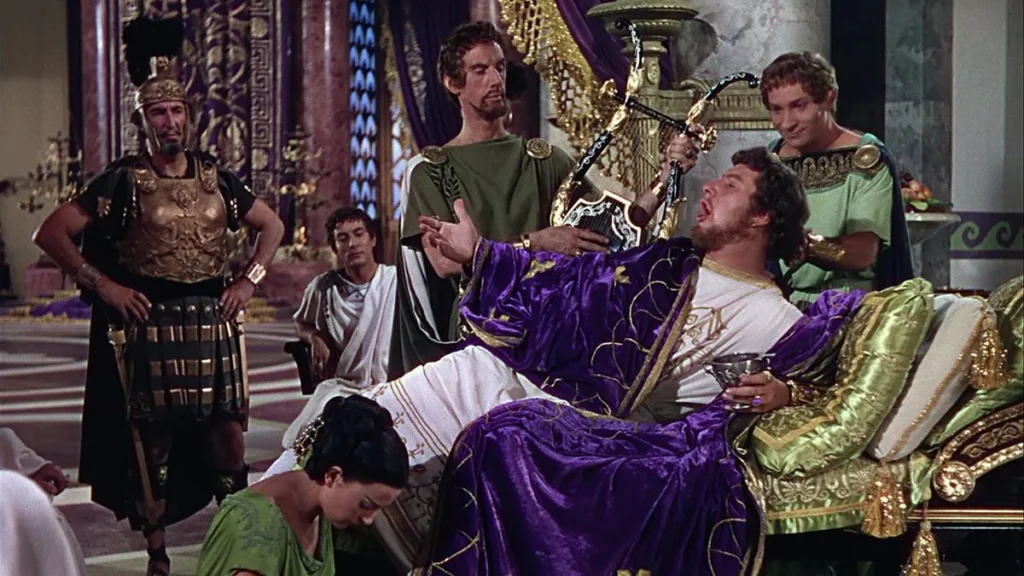
What’s it about? It is set in Ancient Rome during the reign of Emperor Nero. The film follows the love story between a Roman general, Marcus Vinicius, and a Christian woman, Lygia. Their relationship is tested amidst political turmoil and the religious persecution of Christians in Rome. As Marcus becomes intrigued by Lygia’s faith and the teachings of Christianity, he finds himself torn between his loyalty to the empire and his growing love for her. The film culminates in the Great Fire of Rome and the subsequent persecution of Christians, showcasing the triumph of faith and love in the face of adversity.
Why is it great? It’s celebrated for its epic scale, deep and emotionally resonant performances (particularly those of Robert Taylor as Marcus Vinicius and Deborah Kerr as Lygia), and its ability to capture the essence of a significant historical period while conveying timeless themes that resonate with audiences. The film’s powerful scenes, such as the iconic Lion’s Den sequence, leave a lasting impact on viewers.
Fun fact: The production utilized massive sets to recreate Ancient Rome, including a life-sized replica of the Circus Maximus, which was one of the largest sets ever constructed at the time.
5. Julius Caesar (1953)
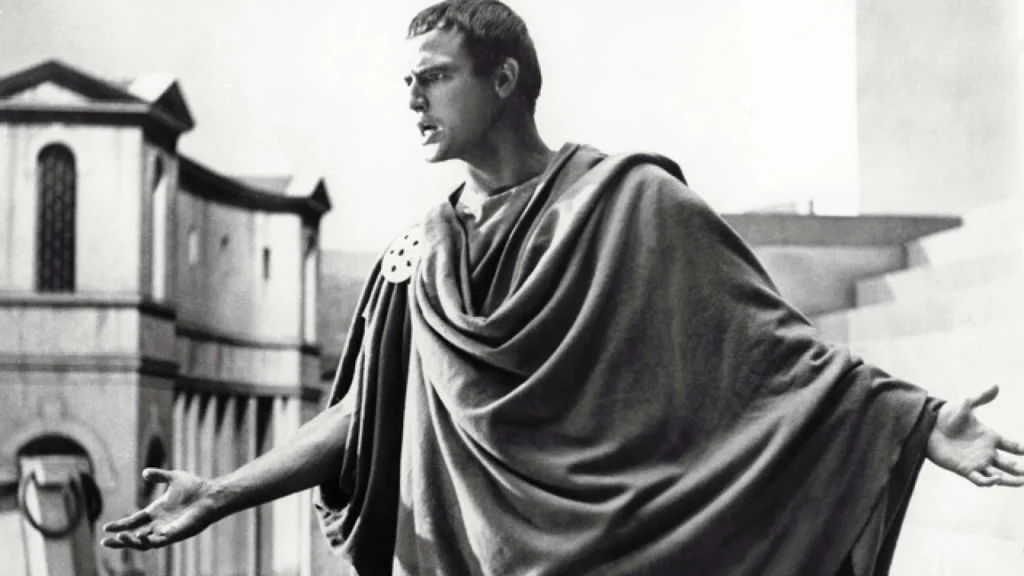
What’s it about? It’s a film adaptation of William Shakespeare’s famous play. The story revolves around the political and personal conflicts surrounding the assassination of Julius Caesar. The film follows the conspirators, led by Brutus and Cassius, as they plot to overthrow Caesar, believing it is for the greater good of Rome. However, the aftermath of the assassination brings chaos and turmoil to the empire, leading to a power struggle and a battle for the future of Rome.
Why is it great? Firstly, it brings one of William Shakespeare’s most renowned plays to life, showcasing the power of his language and storytelling. The film stays true to the essence of the original play, capturing its dramatic intensity and exploring timeless themes of betrayal, ambition, and honor. The performances by a stellar cast, including Marlon Brando as Mark Antony, James Mason as Brutus, and John Gielgud as Cassius, are widely acclaimed for their depth and interpretation of the iconic characters. Moreover, the film’s exploration of political turmoil and the consequences of one’s actions resonates with audiences, providing insights into the complex nature of power and its impact on individuals and societies.
Fun fact: Marlon Brando’s portrayal of Mark Antony, particularly his powerful “Friends, Romans, countrymen” speech, is considered one of the highlights of the film and is often praised as one of the best performances of his career.
4. Cleopatra (1963)
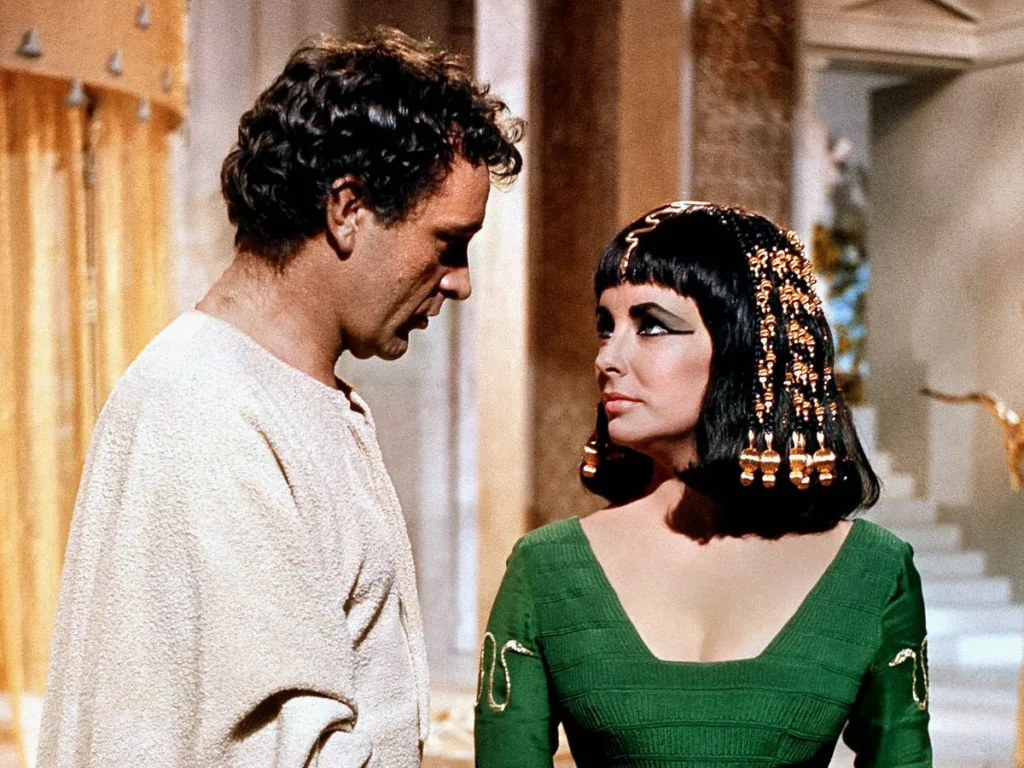
What’s it about? It is an epic historical drama that follows the tumultuous life of Cleopatra, the iconic Queen of Egypt. The film traces her relationships with Julius Caesar and Mark Antony, highlighting the political intrigue and power struggles that ensue. Cleopatra’s ambitious attempts to secure the future of Egypt collide with the Roman Empire’s expanding influence, leading to a web of alliances, betrayals, and romantic entanglements. Amidst lavish settings and intricate costumes, the film explores themes of love, loyalty, and the clash of civilizations, culminating in the climactic Battle of Actium and the tragic downfall of Cleopatra’s empire.
Why is it great? “Cleopatra” is renowned for its ambitious storytelling, delving into political intrigue, romance, and the clash of empires. It presents Cleopatra as a powerful and influential figure, navigating the treacherous world of politics and love. The film explores themes of power, ambition, and the personal sacrifices made in the pursuit of one’s goals. Despite facing production challenges, including budget overruns and on-set controversies, “Cleopatra” remains an enduring classic due to its captivating performances, stunning visuals, and its portrayal of a powerful female ruler in a time of great historical significance.
Fun fact: Elizabeth Taylor’s portrayal of Cleopatra made headlines at the time, not only for her performance but also due to the on-set romance that developed between Taylor and her co-star, Richard Burton, who played Mark Antony. Their highly publicized relationship captivated the media and drew significant attention to the film.
3. Spartacus (1960)

What’s it about? The movie tells the story of a Thracian slave named Spartacus who leads a slave rebellion against the mighty Roman Empire. Sold into slavery and trained as a gladiator, Spartacus becomes a symbol of hope and defiance for his fellow slaves. As their numbers swell, they challenge the oppressive Roman system, sparking a battle for freedom. Spartacus’s journey takes him through triumph and tragedy, as he confronts powerful Roman generals and faces the dilemma of choosing between personal vengeance and the greater cause of liberation for his people.
Why is it great? The film’s direction by Stanley Kubrick showcases his talent for crafting visually stunning and emotionally impactful scenes. The grandeur of the gladiatorial battles, the sweeping landscapes, and the intricate set designs contribute to the film’s epic scale. The film received critical acclaim, earning four Academy Awards, including Best Supporting Actor for Peter Ustinov. It also became a commercial success, solidifying its place as a classic in the epic historical genre.
Fun fact: The battle scenes in “Spartacus” are notable for their scale and intensity. The film employed over 8,000 extras to portray the armies involved in the conflicts, creating epic and visually stunning sequences.
2. Ben-Hur (1959)

What’s it about? The movie tells the story of Judah Ben-Hur, a Jewish prince in Roman-occupied Jerusalem. Falsely accused of treason by his childhood friend, Messala, Ben-Hur endures years of slavery before returning as a skilled charioteer seeking revenge. Alongside his personal journey, the film intertwines with the life of Jesus Christ, portraying the iconic events leading up to the crucifixion and resurrection. Ben-Hur’s path ultimately converges with the life of Jesus, offering a story of redemption, forgiveness, and the triumph of the human spirit.
Why is it great? It showcases remarkable storytelling, blending elements of historical drama, adventure, and religious themes. The film successfully captures the essence of its source material, Lew Wallace’s novel, and delivers a compelling narrative of personal redemption and spiritual transformation. The film’s production values are exceptional, with stunning cinematography, elaborate sets, and grand-scale action sequences. The iconic chariot race scene stands out as one of the most thrilling and well-executed sequences in cinematic history, demonstrating the film’s technical prowess. Moreover, the film explores profound themes of forgiveness, compassion, and the search for meaning in life.
Fun fact: “Ben-Hur” won a record-breaking 11 Academy Awards, including Best Picture, Best Director for William Wyler, and Best Actor for Charlton Heston. It held the record for the most Oscar wins until “Titanic” (1997) and “The Lord of the Rings: The Return of the King” (2003).
1. Gladiator (2000)

What’s it about? The movie follows the story of Maximus Decimus Meridius, a loyal Roman general betrayed by the corrupt Emperor Commodus. Reduced to slavery and forced to become a gladiator, Maximus seeks revenge and fights for his freedom. His skills in the arena lead him to become a beloved symbol of resistance against the tyrannical regime. As Maximus rises through the ranks, he plots to confront Commodus and restore justice to Rome.
Why is it great? It boasts a compelling and well-crafted narrative that combines historical accuracy with gripping storytelling. The film’s direction by Ridley Scott is masterful, showcasing his visual prowess and ability to create atmospheric and immersive settings. One of the film’s standout elements is the exceptional performance by Russell Crowe in the role of Maximus. His portrayal brings depth, strength, and vulnerability to the character, making Maximus a relatable and memorable protagonist. The supporting cast, including Joaquin Phoenix as the manipulative Commodus, further elevates the film with their strong performances. “Gladiator” also benefits from a powerful and evocative musical score by Hans Zimmer, which enhances the emotional impact of the story and contributes to the overall cinematic experience.
Fun fact: The spectacular Colosseum featured in the film was a combination of practical sets and CGI enhancements. The set was constructed to a scale of about one-third the size of the actual Colosseum in Rome.

And that’s our top 10!
If you like the setting of Ancient Rome, you’ll surely enjoy playing our game “Jewels of Rome”! This game is a unique and epic combination of city building and match-3, tied together with a storyline full of twists and turns, Mediterranean culture, and an atmospheric and vibrant setting of Ancient Rome. You’ve been named the Prefect of a troubled settlement in a distant corner of the Roman Empire. Help the determined residents revive their community after a disastrous betrayal by your scheming predecessor, Cassius. Reconstruct an impressive settlement that’s worthy of legends, thwart Cassius’ evil machinations, and ensure that fortune favors your citizens once again!
And for the mahjong players, there’s “Emperor of Mahjong” – with mahjong levels instead of match-3!